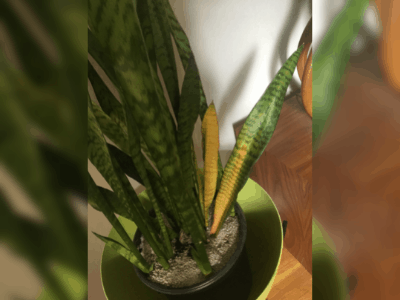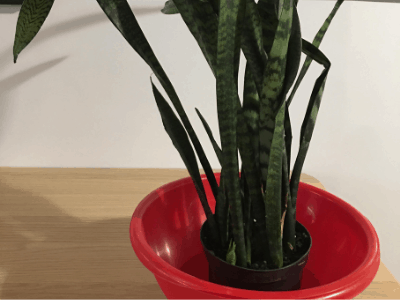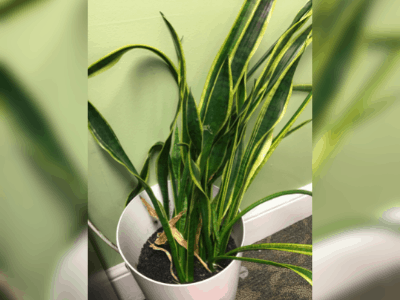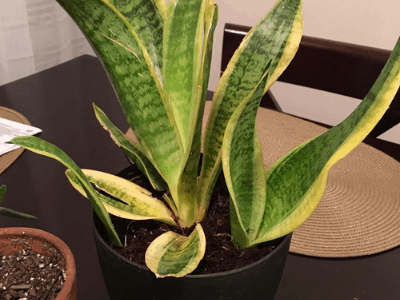Underwatered Snake Plant
A snake plant is known to be a hardy species. Its fleshy leaves lose water slowly…
…no matter how much water they get, and they don’t need it replaced often.
Because of this, snake plants are commonly found in many homes.
Although overwatering is a more common problem with snake plants, it is not impossible to underwater these plants.
In the case of underwatering, the soil is extremely dry before water is added.
This doesn’t mean the plant received too little water.
Find out why plants dehydrate, how to identify its causes and how to save your underwatered snake plant by continuing to read.
Before that, here we have the story from Decker, about her experience having underwatered snake plant issue.
Let us hear Decker’s story
It was a typical Thursday. I woke up, got ready for work and went to the store.
When I got home, I set down my grocery bags and started taking off my shoes when something caught my eye out…
...of the corner of my eye in the kitchen: a snake plant that looked shockingly close to death.
It must have been from all those early morning hours reading articles about how underwatered plants…
...can be a leading cause of dropping leaves because they don’t have enough moisture to keep them green or healthy looking.
I put on some gloves so as not to hurt myself while moving it and watered it thoroughly with cold water…
...which is supposedly better than warm water (unless you’re feeling generous.
Now after a long time treatment, this little buddy finally showing a awesome progress.

Underwatered Snake Plant usually has several symptoms. To bring back their flourished look, you have to confirm the problem and take countermeasures.
Arifur Rahman, Agriculturist from Bangabandhu Sheikh Mujibur Rahman Agricultural University
How Did They Get Dehydrated?
Snake plants are a type of succulent that does not require extreme moisture.
As a result, some people are afraid of overwatering them.
People tend to follow watering regimens without paying close attention to the plant conditions.
During growth season snake plants require moderate watering every 1-2 weeks.
They require less water in the winter, maybe every two to three months, according to their environment.
These are general guidelines applicable to most cases.
Water requirements for individual plants are highly dependent on the light, temperature and humidity they receive.
Occasionally, dehydration is associated with snake plants that have been neglected.
Because Sansevieria plants are best grown in warm and hot climates, they become dormant when the temperature drops.
That is why they require less water, nutrients, and sunlight during the winter.
If you keep your snake plant near a heater or a sunny window, it will consume more water.
However, if it receives less light, it will consume less water. A more aerated atmosphere, dry air…
….or pots coated with porous material such as terracotta may result in a greater moisture loss from soil.
Snake plants love loose, well-draining soil. They need a potting medium that’s fast-draining, but not overly loose.
In order to increase the soil’s water holding capacity, peat, coco coir, and pumice can be added to the soil mix.
In addition to improving soil drainage and increasing oxygen levels while retaining necessary moisture…
…these ingredients improve soil tolerability because they are coarser than regular garden soil.

Symptoms of Underwatered Snake Plant
Inexperienced plant growers may not be able to differentiate between overwatering…
…and underwatering snake plant symptoms. Nevertheless, we can observe some subtle differences.
And the more parts of the plants we examine, the more information we will obtain.
This information is useful for the correct diagnosis of the underwatering problem.

Appearance Of The Leaves
To tell if your snake plant’s leaves have been underwatered, look first and foremost at the appearance of its leaves.
Dehydrated snake plants will have brown tips. The tips of the shoot usually have a dry, crispy texture to them.
After the soil has been left dry for a while, the brown area starts to grow along the edges and down the stem.
The leaves tend to curl. They have wrinkles and are rather shriveled.
To touch, the brown parts feel brittle and dry. If underwatered for too long, the leaves might bend over.
The oldest leaves may appear yellow all over before turning brown.
Yellow leaves can indicate either too wet or too dry soil.
There is actually a distinguishing factor in determining whether you have overwatered the plant.
This can be determined by the leaf texture rather than the color.
Plants that are insufficiently watered develop dry and fragile leaf tips. Such plants grow slowly.
Dryness Of Soil
Providing enough moisture in the soil is the second most important indicator of underwatering.
Checking the soil surface is a reliable indicator of whether a plant requires water.
It’s okay to leave the top soil layer dry. Ideally, the top one to two inches of the soil should be dry…
…before you water your snake plant.
A good potting mix for snake plants will distribute moisture evenly throughout the entire pot.
But when the soil is very dry throughout, it’s a sign of underwatering. The top soil in a pot may be dry…
…but the bottom must retain some amount of moisture.
It means that all the water drained off or evaporated too soon. Examine the soil dampness near the roots…
…using an electronic moisture meter or some other probe.
If it looks dry, then there is not enough water available in the soil.
Brittle Roots
Symptoms of an underwater snake plant include brown tips on leaves and dry soil.
They appear before any root damage occurs. Although snake plant roots rarely become affected in the worst cases of drought…
…when they are not kept moist, they may also become damaged.
During a period of dehydration, the roots become dry and brittle.
If you discover the roots are dead and crumbling off in your fingers, you might find it too late to save the plant.
Causes of Underwatering

Upon noticing the above signs of dehydration, you can determine that your snake plant is underwatered.
The next step is to figure out what is causing this to happen.
You can prevent the causes of underwatering in the future by addressing the problem at its root.
Here are a few of them:
Irregular watering
Snake plants become dehydrated when given less water or watered less frequently.
An ideal way of watering snake plants is to water them thoroughly, letting all the excess water drip off…
…and waiting until the top 1-1.5 inches of the soil layer is dry before watering again.
Using your finger, you can determine how moist the soil is.
You may also use wooden items such as chopsticks or wood popsicle sticks.
Watering your plant 3 – 4 days after watering it with a moisture meter will give you a better idea…
…of the moisture levels near the roots. In case the needle reaches the dry end…
…then you should water the snake plants more often, maybe two or three times a week.
A better way to determine if the soil needs watering is by weighing it.
It is better to try this method in summer, as the plants may not be able to handle the wet soil in winter.
Wait at least a day after you see the plant needing water. Collect water in a saucer or a sink.
After 20 minutes, pick up the plant pot and pay attention to its weight. That is the moist weight.
Check the weight by picking up the pot every few days.
After a few weeks, you will get used to the soil’s texture and water content.
To make things simpler, you can measure the weight on a scale and mark it down.
Fast Water Evaporation
The snake plant may run out of water even if you water it regularly.
For example, a heater can rapidly dry out the soil in a small pot.
Be careful not to keep it in a warm place with a heater nearby.
Plants will need water more frequently when the central heating system is used. In the winter…
…they are likely to require more than just once a month. A ceiling fan or box fan will also accelerate soil evaporation.
Avoid keeping your snake plants too close to these air-circulating devices.
Remove excess water from the soil with a hair dryer, but do not use such a device to damage the leaves.
Too Loose Potting Mix
Most snake plants are afflicted with root rot (from over watering) rather than being harmed by their roots…
…from under watering. A mix that is too loose will allow all water to pass through.
Ingredients like gravel, coarse sand, and pebbles will cause water to drain too quickly.
And pumice, perlite, vermiculite, cococoir help make soils moist while contributing nutrients.
Garden soil and compost make the soil density denser.
In order to maximize moisture holding capacity and drainage, a balance must be found.
Nitrogen Toxicity
This is not as directly related to watering as such, but too much nitrogen in the soil shows…
…similar signs to being underwatered. Burned leaf tips result in these plants turning brown.
A lack of nutrients, including carbon dioxide, can cause the leaves to turn yellow.
This over time will result in burnt roots and damaged stems.
Nitrogen is the most plentiful nutrient added to commercial fertilizers.
Natural fertilizers such as compost also have a greater Nitrogen level than other nutrients.
Nitrogen toxicity may be the reason if you have fertilized the soil too much.
If you are concerned about soil nitrogen, you may want to combine potassium sulfate with one teaspoon of water per gallon.
When using a balanced fertilizer for snake plants, always use a fertiliser balanced in nitrogen…
….phosphorous, and potassium. Don’t overdo it with organic fertilizers in the future.
Go on
How To Save Them?
If a snake plant is in little damage, it can probably be saved. It is not possible to completely heal the leaves once…
…they have been damaged. They will develop a permanent scar if they are damaged.
However, if you protect the roots, new pups will grow from the roots as long as they are healthy.
Identifying the problem and solving it is the first step in saving a drowned snake plant.
Here are some tips on how to get your snake plant looking healthy again.

Cut Off Severely Affected Parts
You may not necessarily have to remove the damaged snake plant leaves if handled properly.
The leaves that still have some healthy and firm parts may still be trimmed back.
The leaves should be totally cut off to look nice in the pot.
Use a sterilized pruning shears, knife or pair of scissors for this.
Fix The Soil Mix
When the ground is loose, it doesn’t retain water. It causes the water that’s poured in to run straight…
…through the holes at the bottom without soaking it.
Adding some peat moss, perlite, coconut fiber or regular soil to the mix may be helpful.
Refrain from adding more than one third of the mix.
Let the plant sit in water for an hour, then for a few days, drain it out and check the moisture level on a regular basis.
Replace the potting medium with a less permeable mix.
It is best to feed snake plants on a regular basis with fast-acting or liquid fertilizers.
Place The Pot In Suitable Environment
Plants in brighter and warmer regions need more water than those in shade and cooler regions.
Keep the plant at a moderate distance from air vents, heaters, etc.
It is important for new plants to receive adequate light until they are well rooted.
This should take at least 3-6 months. Snake plants are fine with some sunlight in the mornings…
…and evenings as long as it is far from the middle of the day. Avoid strong sunlight in any case.
Last but not least…
Follow A Good Watering Regimen
In addition, it is important to observe the appropriate watering regimen according to the conditions of the snake plants you grow.
Snake plants can be watered warmly (80°F or 27°C) in winter.
After the roots are completely dry, you can water them deeply until water runs down the drainage hole.
Snake plant roots should not be kept cold or wet for long. Water them in the morning.
You do not have to completely dry snake plants before watering them, but at least the top layer should be dry.
Sum Up
See having Snake plant is good choice for you to have! It’s cool, its famous, it’s easy to have and care!
What else do you need? In this pandemic time like this, is a good choice for you to have an new activity…
…and having snake plant is a good choice for you to have!
Conclusion
Last thing for sure. This plant need to be care carefully, remember plant need the “love” too.
Alright that’s all for today! Do you have any questions about all of this?
Or do you want to add some method for having and care snake plant so it doesn’t get underwatered?
Let me know your recommendation from the comment below.
I hope you can now take care your snake carefully and grow it big!
Thanks for reading this article! Bye!

